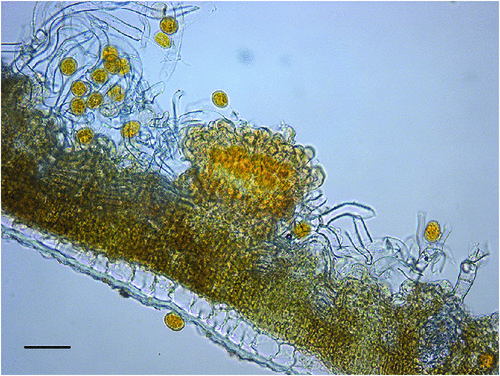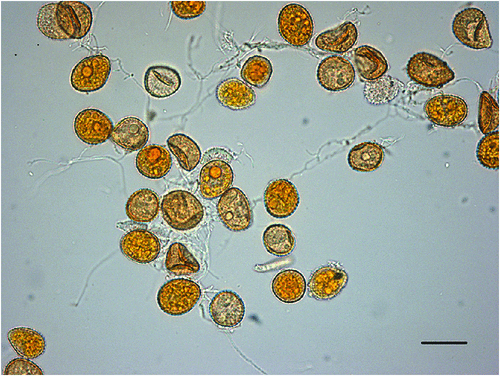First report of teak leaf rust disease caused by Olivea tectonae in Brazil
P. G. C. Cabral A , A. S. Capucho A , O. L. Pereira A , E. Maciel-Zambolim A , R. L. Freitas A and L. Zambolim A BA Departamento de Fitopatologia, Universidade Federal de Viçosa, 36570-000, Viçosa, M.G., Brazil.
B Corresponding author. Email: zambolim@ufv.br
Australasian Plant Disease Notes 5(1) 113-114 https://doi.org/10.1071/DN10041
Submitted: 28 August 2010 Accepted: 27 September 2010 Published: 11 October 2010
Abstract
This note reports the first occurrence of teak leaf rust disease caused by Olivea tectonae in Brazil. High severity of teak leaf rust was found on leaves of ornamental plants in the state of Minas Gerais and Espírito Santo, Brazil.
Teak (Tectona grandis L.f.) originated in India and China (Gradual et al. 1999), but it is also grown in the midwestern areas of Brazil. The first commercial teak plantations in Brazil were established in the 1960s; mostly in the state of Mato Grosso, where an area of around 30 000 ha has been planted (Passos et al. 2006).
Teak is economically very important. It is used in the manufacture of furniture, boat decks and other articles where resistance to the elements is desired. In shipbuilding teak is practically irreplaceable due to its resistance to sun, heat, cold, rain and sea water (Rondon Neto et al. 1998).
Teak leaf rust, caused by Olivea tectonae (T.S. Ramakr. & K. Ramakr.) R.L. Mulder., is reported in this work for the first time in Brazil. The fungus was collected on an ornamental teak plant of ~10 years old, in the region of Guaraciaba (578 m altitude, 20°60′29S and 43°05′43W), state of Minas Gerais, Brazil, in July 2010. One month later, leaf rust was also observed on other ornamental teak plants approximately 5 years old around the city of Viçosa (648 m altitude, 20°77′40S and 42°87′52W), also in Minas Gerais, and also in the Governador Lindemberg region (550 m altitude), state of Espírito Santo. Voucher specimens were deposited in the herbarium of the Universidade Federal de Viçosa (Herbarium Vic.) under the accession numbers: Vic. 31397 (Guaraciaba sample) and Vic. 31398 (Viçosa sample).
The symptoms observed on the leaves of the diseased plants consisted of small, angular brown to grey necrotic areas on the adaxial leaf surface. As the disease progressed, the lesions enlarged and coalesced to form larger necrotic lesions. The necrotic areas corresponded to numerous subepidermal areas of erumpent uredinia on the abaxial leaf surface. The lesions were also observed on the inflorescences of the plant (Fig. 1). Severely infected plants had lost most of their leaves.

|
Light microscope analysis revealed subepidermal erumpent uredinia measuring 90–180 × 55–112.5 μm, with basally united peripheral paraphyses of the Malupa-type, and hyaline to pale brown incurved uredinial paraphyses measuring 35–52.5 × 10–17.5 μm (Fig. 2). The urediniospores were produced singly on a short pedicel, subglobose or ellipsoid, mostly hyaline, occasionally pale brown, measured 17.5–25 μm (subglobose) and 22.5–30 × 15–22.5 μm (ellipsoid), echinulate (Fig. 3). Teliospores were not observed. The hyperparasite Acremonium sp. was commonly associated with the pustules of O. tectonae.

|

|
Olivea tectonae is known throughout Asia; mainly in Bangladesh, Myanmar, China, India, Indonesia, Pakistan, Philippines, Sri Lanka, Taiwan, Thailand and Vietnam (Boedijn 1959; Lorsuwan et al. 1984; Kobayashi and Guzman 1988; Kaneko et al. 2007). Recently the fungus was identified in Australia, Central America (specifically in Cuba, Mexico, Costa Rica and Panama) (Arguedas 2004; EPPO 2005; Daly et al. 2006; Perez et al. 2008) and South America (Ecuador) (EPPO 2005). This is the first report of teak leaf rust in Brazil. It is possible that the pathogen arrived in South America via spores being carried by wind currents presumably from Central America.
Acknowledgements
The authors acknowledge the Conselho Nacional de Desenvolvimento Científico e Tecnológico (CNPq) for providing financial support. P.G.C. Cabral, A.S. Capucho and L. Zambolim acknowledge the Conselho Nacional de Desenvolvimento Científico e Tecnológico – CNPq for providing the financial support.
References
Arguedas M (2004) La roya de la tecta Olivea tectonae (Rac.): consideraciones sobre su presencia em Panama y Costa Rica. Kuru: Revista Forest. (Costa Rica) 1, 1–6.Boedijn KB (1959) The Uredinales of Indonesia. Nova Hedwigia 1, 463–496.
Daly AM, Shivas RG, Pegg GS, Mackie AE (2006) First record of teak leaf rust (Olivea tectonae) in Australia. Australasian Plant Disease Notes 1, 25–26.
| First record of teak leaf rust (Olivea tectonae) in Australia.Crossref | GoogleScholarGoogle Scholar |
European and Mediterranean Plant Protection Organization (EPPO) (2005) Available at http://www.eppo.org/ [Accessed 19 September 2010].
Gradual L, Kjaer ED, Suangtho V, Saardavut P, Kaosa-Ard A (1999) Conservation of genetic resources of teak (Tectona grandis) in Thailand. In ‘DFSC Series of Technical Notes’. (Ed. F Linn) (Humlebaek: Danida Forest Seed Centre)
Kaneko S, Pham TQ, Hiratsuka Y (2007) Notes on some rust fungi in Vietnam. Mycoscience 48, 263–265.
| Notes on some rust fungi in Vietnam.Crossref | GoogleScholarGoogle Scholar |
Kobayashi T, Guzman E (1988) Notes on Tree Diseases and Associated Micro-organisms observed from 1977 to 1985 in the Philippines. Japan Agricultural Research Quarterly 22, 65–70.
Lorsuwan C, Tontyaporn S, Visarathanonth N, Manoch L, Kakishima M (1984) Materials for the rust flora in Thailand I. Trans Mycol Soc Japan 25, 57–65.
Passos CAM, Junior LB, Gonçalves MR (2006) Avaliação silvicultural de Tectona grandis L.f., em Cárceres-MT, Brasil: Resultados preliminares. Ciência Florestal 16, 225–232.
Perez M, Lopez MO, Marti O (2008) Olivea tectonae, leaf rust of teak, occurs in Cuba. New Disease Reports 17, 32
Rondon Neto RM, Macedo RLG, Tsukamoto AA (1998) Formação de povoamento florestal com Tectona grandis L.f. Boletim Técnico-Série Extensão 7, 1–29.


